Architectural Sculpture
0.0(0)
Card Sorting
1/10
Earn XP
Description and Tags
Study Analytics
Name | Mastery | Learn | Test | Matching | Spaced |
|---|
No study sessions yet.
11 Terms
1
New cards
Herakles and Kerkopes
575-550BC, Temple C, Selinus
Story:
When Herakles was asleep, the two Kerkopes (imp-like people) stole his weapons. When the hero woke up he caught them and tied them to a pole and carried them over his shoulders. From this peculiar vantage point the Kerkopes had an excellent view of Herakles' hairy bottom. They so amused him by the jokes they made on this subject that he eventually let them go.
Pros:
• All three figures look to the front and Herakles walks firmly to the right. His legs provide enlivening diagonal accents in a composition that is otherwise dominated by verticals and horizontals.
• The two Kerkopes hang in mirror images of each other, even their arms, hair and faces are arranged to create symmetry.
• Pleasing symmetry - e.g kerkopes mirror each other.
• Pleasing repetition and geometric shapes (e.g triangles) and patterns (e.g) their locks - which show gravity.
• Tells an effective story with the injection of humour
Cons:
• It is carved in shallow relief meaning the figures are not very rounded and the whole design is very flat.
• Originally the image was sharpened by paint for the details of the figures, their hair, eyes and clothing and background were all coloured.
• Top heavy - too much space below.
• Torso broad and stocky - wrong proportions.
• But archaic - for those who rate realism over stylisation - archaic features.
• No Herakleian attributes depicted - no club or lion skin etc
Story:
When Herakles was asleep, the two Kerkopes (imp-like people) stole his weapons. When the hero woke up he caught them and tied them to a pole and carried them over his shoulders. From this peculiar vantage point the Kerkopes had an excellent view of Herakles' hairy bottom. They so amused him by the jokes they made on this subject that he eventually let them go.
Pros:
• All three figures look to the front and Herakles walks firmly to the right. His legs provide enlivening diagonal accents in a composition that is otherwise dominated by verticals and horizontals.
• The two Kerkopes hang in mirror images of each other, even their arms, hair and faces are arranged to create symmetry.
• Pleasing symmetry - e.g kerkopes mirror each other.
• Pleasing repetition and geometric shapes (e.g triangles) and patterns (e.g) their locks - which show gravity.
• Tells an effective story with the injection of humour
Cons:
• It is carved in shallow relief meaning the figures are not very rounded and the whole design is very flat.
• Originally the image was sharpened by paint for the details of the figures, their hair, eyes and clothing and background were all coloured.
• Top heavy - too much space below.
• Torso broad and stocky - wrong proportions.
• But archaic - for those who rate realism over stylisation - archaic features.
• No Herakleian attributes depicted - no club or lion skin etc
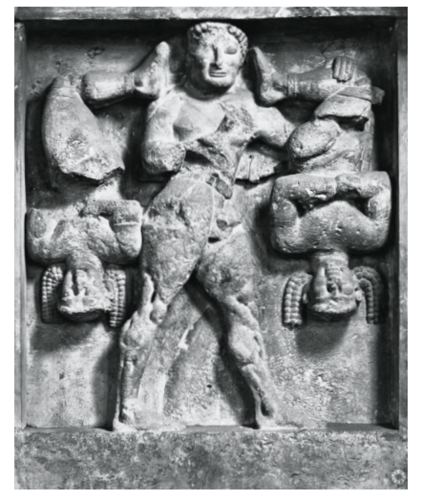
2
New cards
The Heroic Cattle Raid - Dioscuri
575-550BC, Sikyonian Treasury Delphi
Storyline:
Castor and Pollux aspired to marry the Leucippides ('daughters of the white horse'), Phoebe and Hilaeira, whose father was a brother of Leucippus ('white horse'). Both women were already betrothed to cousins of the Dioscuri, the twin brothers Lynceus and Idas of Thebes. Castor and Pollux carried the women off to Sparta, wherein each has a son. This consequently started a family feud between the four sons of the two brothers Tyndareus and Aphareus. The cousins carried out a cattle-raid in Arcadia together, but fell out over the division of the meat. The story went that after they had stolen the herd, but before they had divided it, the cousins killed, cooked, and divided a calf into quarters. As they prepared to eat, the gigantic Idas suggested that, based on whichever pair of brothers finished their meal first, the herd would be divided into two. Castor and Pollux agreed, but Idas tricked them, by eating both his and his brother's portion. Castor and Pollux let them take the herd, but vowed one day to take their revenge. Some time later, Idas and Lynceus visited their uncle in Sparta. However, he was on the way to Crete, so he left Helen to entertain the guests, which included both sets of brothers, as well as Paris. Castor and Pollux realised their chance for revenge, and left early, planning to steal the herd of Idas and his brother. Eventually, Lynceus and Idas also left, which gave Paris a chance to kidnap Helen, thus giving rise to the events of the Trojan War. Meanwhile, Castor and Pollux were stealing cattle, the former keeping watch in a tree. As the other two brothers approached, Lynceus saw Castor in the tree, and realised what was happening. Idas, furious, fatally wounded Castor, but not before he called out to warn Pollux, who killed Lynceus in retaliation. As Idas was about to kill Pollux, Zeus looked down and killed him with a lightning bolt, to save his beloved son.
How do we know it's archaic?
* Repetition of patterns and figures
* All the figures look the same and wear the same clothes, despite the different status of each
* Unnatural position of cattle (head to the front, legs to the side)
* Lots of vertical lines through the figures, diagonal lines with the spears, and triangles
* They are all walking in step, in a tightly knit pattern
Storyline:
Castor and Pollux aspired to marry the Leucippides ('daughters of the white horse'), Phoebe and Hilaeira, whose father was a brother of Leucippus ('white horse'). Both women were already betrothed to cousins of the Dioscuri, the twin brothers Lynceus and Idas of Thebes. Castor and Pollux carried the women off to Sparta, wherein each has a son. This consequently started a family feud between the four sons of the two brothers Tyndareus and Aphareus. The cousins carried out a cattle-raid in Arcadia together, but fell out over the division of the meat. The story went that after they had stolen the herd, but before they had divided it, the cousins killed, cooked, and divided a calf into quarters. As they prepared to eat, the gigantic Idas suggested that, based on whichever pair of brothers finished their meal first, the herd would be divided into two. Castor and Pollux agreed, but Idas tricked them, by eating both his and his brother's portion. Castor and Pollux let them take the herd, but vowed one day to take their revenge. Some time later, Idas and Lynceus visited their uncle in Sparta. However, he was on the way to Crete, so he left Helen to entertain the guests, which included both sets of brothers, as well as Paris. Castor and Pollux realised their chance for revenge, and left early, planning to steal the herd of Idas and his brother. Eventually, Lynceus and Idas also left, which gave Paris a chance to kidnap Helen, thus giving rise to the events of the Trojan War. Meanwhile, Castor and Pollux were stealing cattle, the former keeping watch in a tree. As the other two brothers approached, Lynceus saw Castor in the tree, and realised what was happening. Idas, furious, fatally wounded Castor, but not before he called out to warn Pollux, who killed Lynceus in retaliation. As Idas was about to kill Pollux, Zeus looked down and killed him with a lightning bolt, to save his beloved son.
How do we know it's archaic?
* Repetition of patterns and figures
* All the figures look the same and wear the same clothes, despite the different status of each
* Unnatural position of cattle (head to the front, legs to the side)
* Lots of vertical lines through the figures, diagonal lines with the spears, and triangles
* They are all walking in step, in a tightly knit pattern
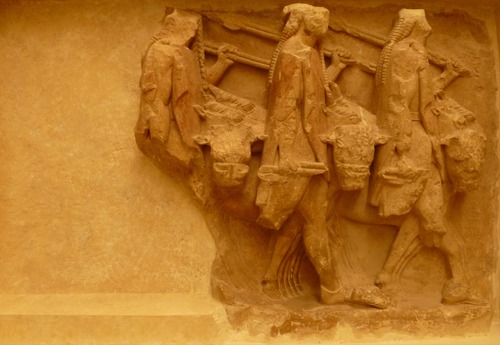
3
New cards
Cretan Bull
475-450BC, Temple of Zeus, Olympia
Location: Temple of Zeus at Olympia (4th metope on the rear porch - west side)
Storyline:
Herakles was sent to capture the bull by Eurystheus as his seventh task. He sailed to Crete, whereupon Minos gave Heracles permission to take the bull away as he had been wreaking havoc on Crete by uprooting crops and leveling orchard walls. Heracles captured the bull, and then shipped him to Eurystheus in Tiryns. The bull later broke loose and wandered into Marathon, becoming known as the "Marathonian Bull".
How do we know it's classical?
* Pose is far more bold than on metopes from the archaic period (e.g. Herakles and the Kerkopes)
* He is highly muscular but the surface of the stone appears softer and more skin-like
* More natural shape and pose
* Suggestion of movement
* The composition has a sense of drama and dynamic energy
* Uses the space well - figures pulling outwards but focus pulled inwards
* He has a slight beard, suggesting variation in age - archaic sculpture usually depicted people of the same age (young and athletic)
* Facial expression is active, displaying emotion, rather than serene as in archaic metopes
Is it successful as a depiction of Herakles?
* Links to the temple and other metopes on the temple
* Symbolism: Herakles was Zeus' most famous son so it is appropriate to honour him, and in doing so it also honours Zeus
* He is depicted with his club, and in the process of one of his labours
* Herakles is muscular
* Herakles' strength is conveyed through his conquering of the bull, and the celebration of his physical abilities would surely have been relevant to the competing athletes at Olympia, as the metope seems to be depicting the ideal athlete
* Herakles can also be seen to be representing the forces of civilisation, while the bull represents savagery and the beastiality associated with Crete
Notes:
* The monstrous bulk of the bull is accentuated by the fact that it has to turn its head to fit into the frame of the metope
* The crossover also suggests depth, as does the bull's turned and foreshortened head
* The grossed figures of Herakles and the bull create a pair of strong diagonal lines, which produces a strong focal point for the viewer's gaze
* Intensity of eye contact creates a sense of the composition being self-contained
Location: Temple of Zeus at Olympia (4th metope on the rear porch - west side)
Storyline:
Herakles was sent to capture the bull by Eurystheus as his seventh task. He sailed to Crete, whereupon Minos gave Heracles permission to take the bull away as he had been wreaking havoc on Crete by uprooting crops and leveling orchard walls. Heracles captured the bull, and then shipped him to Eurystheus in Tiryns. The bull later broke loose and wandered into Marathon, becoming known as the "Marathonian Bull".
How do we know it's classical?
* Pose is far more bold than on metopes from the archaic period (e.g. Herakles and the Kerkopes)
* He is highly muscular but the surface of the stone appears softer and more skin-like
* More natural shape and pose
* Suggestion of movement
* The composition has a sense of drama and dynamic energy
* Uses the space well - figures pulling outwards but focus pulled inwards
* He has a slight beard, suggesting variation in age - archaic sculpture usually depicted people of the same age (young and athletic)
* Facial expression is active, displaying emotion, rather than serene as in archaic metopes
Is it successful as a depiction of Herakles?
* Links to the temple and other metopes on the temple
* Symbolism: Herakles was Zeus' most famous son so it is appropriate to honour him, and in doing so it also honours Zeus
* He is depicted with his club, and in the process of one of his labours
* Herakles is muscular
* Herakles' strength is conveyed through his conquering of the bull, and the celebration of his physical abilities would surely have been relevant to the competing athletes at Olympia, as the metope seems to be depicting the ideal athlete
* Herakles can also be seen to be representing the forces of civilisation, while the bull represents savagery and the beastiality associated with Crete
Notes:
* The monstrous bulk of the bull is accentuated by the fact that it has to turn its head to fit into the frame of the metope
* The crossover also suggests depth, as does the bull's turned and foreshortened head
* The grossed figures of Herakles and the bull create a pair of strong diagonal lines, which produces a strong focal point for the viewer's gaze
* Intensity of eye contact creates a sense of the composition being self-contained
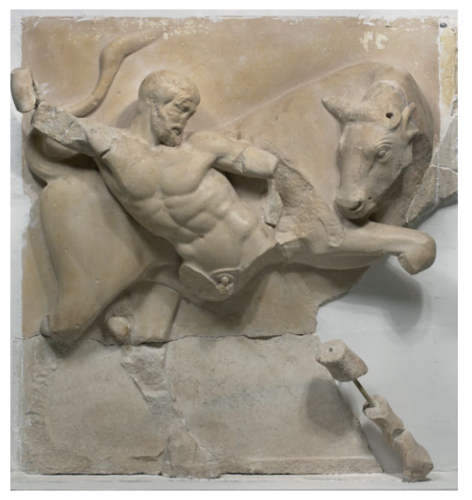
4
New cards
Garden of the Hesperides
475-450BC, Temple of Zeus, Olympia
Storyline:
Heracles made his way to the garden of the Hesperides, where he encountered Atlas holding up the heavens on his shoulders. Heracles persuaded Atlas to get the three golden Apples for him by offering to hold up the heavens in his place for a little while. Atlas could get the apples because, in this version, he was the father or otherwise related to the Hesperides. This would have made the labour - like the Hydra and the Augean stables - void because Heracles had received help. When Atlas returned, he decided that he did not want to take the heavens back, and instead offered to deliver the apples himself, but Heracles tricked him by agreeing to remain in place of Atlas on the condition that Atlas relieve him temporarily while Heracles adjusted his cloak. Atlas agreed, but Heracles reneged and walked away with the apples. According to an alternative version, Heracles slew Ladon, the dragon who guarded the apples instead. Eurystheus was furious that Heracles had accomplished something that Eurystheus thought could not possibly be done.
How do we know it's classical?
* Realistic drapery on Athena, smooth where the leg is bent (protrudes), uninterrupted folds on leg supporting weight
Is it successful as a depiction of Herakles?
* As it is one of his final labours, he is shown to be quite mature (beard)
* The storyline is highly recognisable, and despite how static the three figures appear, the use of motifs and space make it better
* However, especially from a distance the apples are very small and unnoticeable, making the plot less obvious
Notes:
* Herakles is in profile, Athena is fully frontal, and Atlas has a ¾ view : variety of positions
* Contrast is again achieved: Herakles is still, holding up the sky, and Atlas is moving, representing freedom
* 3 strong verticals dominate, but it is enlivened by horizontal lines of Atlas' outstretched arm
* The frame of the metope is used to help convey the narrative, the top of the metope depicts the sky
* The differences between gods and mortals are shown through Herakles being a head shorter, but despite his comparative shortness he appears to be roughly the same size thanks to the inclusion of a cushion he is using to help hold up the sky
* Atlas, as a titan, represents the forces of barbarity, so Herakles defeating him shows the triumph of civilisation over that
* Athena's arm is raised to catch the sky if Hercules drops it. This shows divine support for the forces of civilisation in the battle between civilisation and barbarity. Her lack of helmet, aegis, shield (though spear held vertically against edge of metope) emphasises her care and support rather than militaristic image.
Storyline:
Heracles made his way to the garden of the Hesperides, where he encountered Atlas holding up the heavens on his shoulders. Heracles persuaded Atlas to get the three golden Apples for him by offering to hold up the heavens in his place for a little while. Atlas could get the apples because, in this version, he was the father or otherwise related to the Hesperides. This would have made the labour - like the Hydra and the Augean stables - void because Heracles had received help. When Atlas returned, he decided that he did not want to take the heavens back, and instead offered to deliver the apples himself, but Heracles tricked him by agreeing to remain in place of Atlas on the condition that Atlas relieve him temporarily while Heracles adjusted his cloak. Atlas agreed, but Heracles reneged and walked away with the apples. According to an alternative version, Heracles slew Ladon, the dragon who guarded the apples instead. Eurystheus was furious that Heracles had accomplished something that Eurystheus thought could not possibly be done.
How do we know it's classical?
* Realistic drapery on Athena, smooth where the leg is bent (protrudes), uninterrupted folds on leg supporting weight
Is it successful as a depiction of Herakles?
* As it is one of his final labours, he is shown to be quite mature (beard)
* The storyline is highly recognisable, and despite how static the three figures appear, the use of motifs and space make it better
* However, especially from a distance the apples are very small and unnoticeable, making the plot less obvious
Notes:
* Herakles is in profile, Athena is fully frontal, and Atlas has a ¾ view : variety of positions
* Contrast is again achieved: Herakles is still, holding up the sky, and Atlas is moving, representing freedom
* 3 strong verticals dominate, but it is enlivened by horizontal lines of Atlas' outstretched arm
* The frame of the metope is used to help convey the narrative, the top of the metope depicts the sky
* The differences between gods and mortals are shown through Herakles being a head shorter, but despite his comparative shortness he appears to be roughly the same size thanks to the inclusion of a cushion he is using to help hold up the sky
* Atlas, as a titan, represents the forces of barbarity, so Herakles defeating him shows the triumph of civilisation over that
* Athena's arm is raised to catch the sky if Hercules drops it. This shows divine support for the forces of civilisation in the battle between civilisation and barbarity. Her lack of helmet, aegis, shield (though spear held vertically against edge of metope) emphasises her care and support rather than militaristic image.
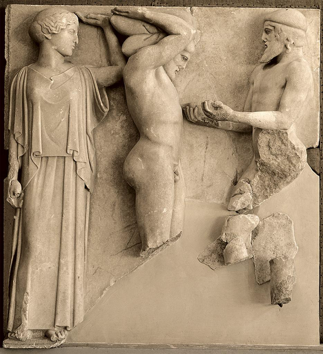
5
New cards
Stables of Augeas
475-450BC, Temple of Zeus, Olympia
Storyline:
For his fifth labour, Herakles was ordered to clean King Augeas' stables. This assignment was intended to be both humiliating and impossible, since these divine livestock were immortal, and had produced an enormous quantity of dung. The Augean stables had not been cleaned in over 30 years, and over 1,000 cattle lived there. However, Heracles succeeded by rerouting the rivers Alpheus and Peneus to wash out the filth. Before starting on the task, Heracles had asked Augeas for one-tenth of the cattle if he finished the task in one day, and Augeas agreed, but afterwards Augeas refused to honour the agreement on the grounds that Heracles had been ordered to carry out the task by Eurystheus anyway. Heracles claimed his reward in court, but the success of this labour was ultimately discounted because Eurystheus said it didn't count, due to his payment and the rivers technically having done the work.
How do we know it's classical?
* Bold pose and good use of space
* Athena's helmet pokes out of the metope, showing experimentation as well as symbolizing her authority
* His figure and position suggest vigour and activity
* This metope is at the east end on the far right, out of order because it's a more local event
Is it successful as a depiction of Herakles?
* Herakles is depicted as muscular
* The storyline is recognisable, and Athena's accessories help to make it even more identifiable
Notes:
* The parallel diagonal lines of the shovel and spear are effective in pointing towards the action, and giving movement to the metope
Storyline:
For his fifth labour, Herakles was ordered to clean King Augeas' stables. This assignment was intended to be both humiliating and impossible, since these divine livestock were immortal, and had produced an enormous quantity of dung. The Augean stables had not been cleaned in over 30 years, and over 1,000 cattle lived there. However, Heracles succeeded by rerouting the rivers Alpheus and Peneus to wash out the filth. Before starting on the task, Heracles had asked Augeas for one-tenth of the cattle if he finished the task in one day, and Augeas agreed, but afterwards Augeas refused to honour the agreement on the grounds that Heracles had been ordered to carry out the task by Eurystheus anyway. Heracles claimed his reward in court, but the success of this labour was ultimately discounted because Eurystheus said it didn't count, due to his payment and the rivers technically having done the work.
How do we know it's classical?
* Bold pose and good use of space
* Athena's helmet pokes out of the metope, showing experimentation as well as symbolizing her authority
* His figure and position suggest vigour and activity
* This metope is at the east end on the far right, out of order because it's a more local event
Is it successful as a depiction of Herakles?
* Herakles is depicted as muscular
* The storyline is recognisable, and Athena's accessories help to make it even more identifiable
Notes:
* The parallel diagonal lines of the shovel and spear are effective in pointing towards the action, and giving movement to the metope
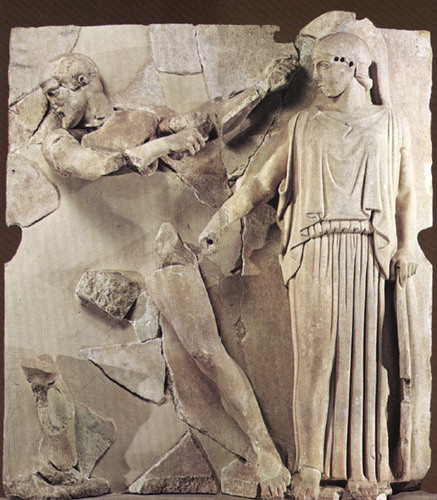
6
New cards
XXVI
447-442BC, Parthenon, Athens
Storyline:
Lapiths were a race of legendary men, who lived in the north of Greece. Their neighbors were centaurs, and so out of courtesy the Lapith king invited them to his wedding. However, they got drunk and misbehaved, attacking and attempting to rape the Lapith women. A violent fight broke out, and the Lapiths were the victors, driving the centaurs from the country.
Critic quotes:
1. 'their poses have been carefully arranged to fill the entire space'
2. 'the anatomy of both contestants is rendered with vigour and ease'
3. 'notice the blank expanse to the right'
4. 'the figures are awkward; harsh lines indicate their muscles; the centaur appears to have no neck'
5. 'his flattened face is crude and ill-executed'
6. 'incompetently carved'
* All are taken from page 114 of Susan Woodford' textbook
Positives vs negatives:
* Nice parallel lines
* Figures interacting with one another
* Triangle shape, eyes drawn towards the centre
* Bad use of space, gaps around the outside
* Less refined than others
* Drapery is very 2D and unrealistic, appears half-finished
* Muscle definition is attempted, but lines are crude and harsh
Storyline:
Lapiths were a race of legendary men, who lived in the north of Greece. Their neighbors were centaurs, and so out of courtesy the Lapith king invited them to his wedding. However, they got drunk and misbehaved, attacking and attempting to rape the Lapith women. A violent fight broke out, and the Lapiths were the victors, driving the centaurs from the country.
Critic quotes:
1. 'their poses have been carefully arranged to fill the entire space'
2. 'the anatomy of both contestants is rendered with vigour and ease'
3. 'notice the blank expanse to the right'
4. 'the figures are awkward; harsh lines indicate their muscles; the centaur appears to have no neck'
5. 'his flattened face is crude and ill-executed'
6. 'incompetently carved'
* All are taken from page 114 of Susan Woodford' textbook
Positives vs negatives:
* Nice parallel lines
* Figures interacting with one another
* Triangle shape, eyes drawn towards the centre
* Bad use of space, gaps around the outside
* Less refined than others
* Drapery is very 2D and unrealistic, appears half-finished
* Muscle definition is attempted, but lines are crude and harsh
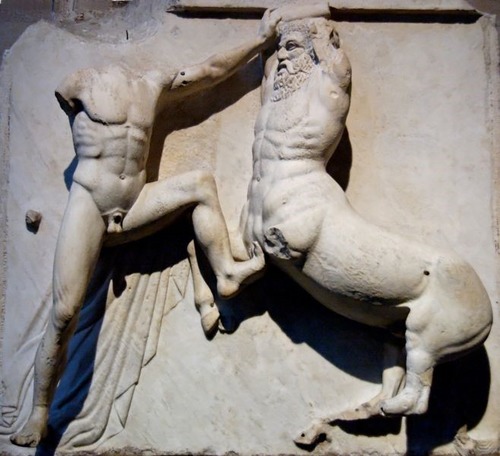
7
New cards
XXVII
447-442BC, Parthenon, Athens
Why is it successful?
* Full of dynamic action, successfully capture the intensity of the scene
* Detailed drapery emphasises the dramatic pose
* Good use of space (centrified composition)
* Successful drapery appears almost 3D, in contrast to metope 26
* Figures draw away from one another, square shape from parallel lines draws the eye in (lapith arm and horse back)
* Symmetry, but with enough variation that it keeps it interesting
* Very high relief, recognisable story line - successful as a metope
* Good muscle definition shown
How do we know it's from the high classical period?
Critic quotes:
1. 'rippling muscles and tensed bodies contrasts with the geometric purity of the folds behind'
2. 'superbly effective sculpted drapery'
3. 'the dynamic opposition of the two figures cleverly carried the design out to the sides of the metope'
4. 'the strong paternity created by the folds of the cloak serves to stabilise the otherwise centrifugal composition'
* All taken from pages 114-115 of the Woodford textbook
Why is it successful?
* Full of dynamic action, successfully capture the intensity of the scene
* Detailed drapery emphasises the dramatic pose
* Good use of space (centrified composition)
* Successful drapery appears almost 3D, in contrast to metope 26
* Figures draw away from one another, square shape from parallel lines draws the eye in (lapith arm and horse back)
* Symmetry, but with enough variation that it keeps it interesting
* Very high relief, recognisable story line - successful as a metope
* Good muscle definition shown
How do we know it's from the high classical period?
Critic quotes:
1. 'rippling muscles and tensed bodies contrasts with the geometric purity of the folds behind'
2. 'superbly effective sculpted drapery'
3. 'the dynamic opposition of the two figures cleverly carried the design out to the sides of the metope'
4. 'the strong paternity created by the folds of the cloak serves to stabilise the otherwise centrifugal composition'
* All taken from pages 114-115 of the Woodford textbook
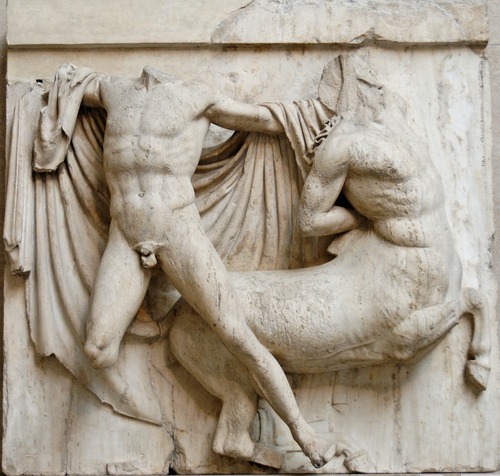
8
New cards
XXVIII
447-442BC, Parthenon, Athens
Why is it successful?
* It depicts the centaur most successfully (e.g. holding an animal skin, sense of drunkenness), and there was originally a wine jar in the centaur's right hand (now lost)
* Drapery appears slightly see through
* Parallel lines and strong horizontals
* Sense of anticipation (rearing up in triumph before crashing down)
* Animal skin represents bestial nature of centaurs (barbaric)
How do we know it's high classical?
Critic quotes:
1. 'sensitively rendered body crumpled pathetically in death'
2. 'the triumphant centaur rears above his victim'
Why is it successful?
* It depicts the centaur most successfully (e.g. holding an animal skin, sense of drunkenness), and there was originally a wine jar in the centaur's right hand (now lost)
* Drapery appears slightly see through
* Parallel lines and strong horizontals
* Sense of anticipation (rearing up in triumph before crashing down)
* Animal skin represents bestial nature of centaurs (barbaric)
How do we know it's high classical?
Critic quotes:
1. 'sensitively rendered body crumpled pathetically in death'
2. 'the triumphant centaur rears above his victim'
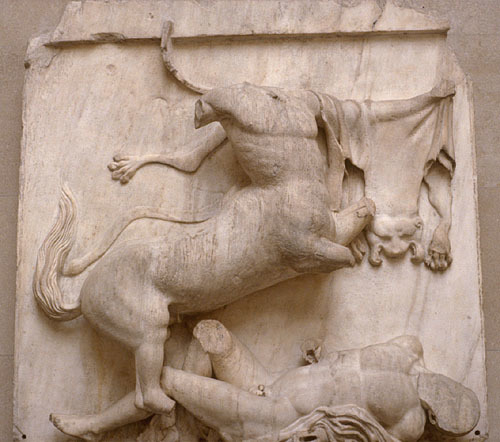
9
New cards
Temple of Artemis
590-580BC, Corcyra (Corfu)
Overview
* The centre of the pediment is filled with a running figure of a Gorgon.
* This protected the temple from evil spirits as well as representing a well known myth.
* The Temple of Artemis is an ancient edifice in Corfu, Greece, built in archaic-style around 580 BC in the ancient city of Korkyra, in what is known today as the suburb of Garitsa. The temple was dedicated to Artemis and functioned as a sanctuary. It is known as the first Doric temple exclusively built with stone. It is also considered the first building to have incorporated all of the elements of the Doric architectural style.
* The temple was a peripteral-styled building with a pseudodipteral configuration. Its perimeter was rectangular, with width of 77 ft. (23.46 m) and length 161 ft. (49 m) with an eastward orientation so that light could enter the interior of the temple at sunrise. It was one of the largest temples of its time.
* The metope of the temple was probably decorated, since remnants of reliefs featuring Achilles and Memnon were found in the ancient ruins. The temple has been described as a milestone of Ancient Greek architecture and one of 150 masterpieces of Western architecture.
Features
* The pediment depicts Medusa in a formulaic, stylised fashion; her feet are arranged in a configuration suggesting rotation, which in turn indicates motion or flight when applied to the attributes of Medusa, especially Medusa's wings. The Medusa is wearing a mini-skirt which allows her legs freedom of movement while she is fleeing from Perseus. Her motion is further indicated by the formulaic positioning of her legs.
* The Gorgon is shown with a girdle of intertwined serpents; the girdle is a fertility symbol traditionally associated with female reproduction and sexuality. The presence of the snakes, however, adds a demonic quality as well as an element of danger. Two more snakes radiate outward from her neck
* Her children, Pegasus and Khrysaor, are at each side of her, despite the fact that they were born after her death. The face of Medusa is repulsive and shows an evil "archaic smile". The panthers, flanking Medusa on each side, serve as temple guardians and they gaze outward as if to visually inspect their domain.
* The head of the Medusa figure clashes with the pediment outline and evokes a frightening effect. It has also been suggested that since it is unusual for Artemis not to be depicted on the pediment of her own Temple, Medusa may represent the demonic side of Artemis, since both entities were patrons of animals.
* The function of the Medusa and panther figures is believed to be warding-off evil and prevent it from entering the temple.
* Behind the leopard on the left lies a seated figure Priam about to be killed by Pyrrhus. The spear-wielding figure has disappeared from the pediment.
* Behind the seated figure, on its left, lies a bearded figure of a dead Trojan warrior, facing outward from the pediment.
* Behind the leopard to the right, two figures are shown. The standing figure closest to the leopard is believed to be Zeus who is depicted in partial profile wielding a thunderbolt against another figure - a giant, which faces outward from the pediment. The figure is presented with a beard and is kneeling. To the right of these figures, another relief of a dead warrior (giant) is believed to have existed.
Since these figures are not connected to the legend of Medusa, it is thought that the apotropaic function of temple symbols such as the Medusa and the panthers, as guardian symbols of the Temple, is starting to be replaced by the idea of using figures and themes from mythical stories as temple decoration. The decorative function, in time, prevailed over the apotropaic one.
Strengths
* This pediment is impressive due to its size (Medusa is over 3m tall), decorative effectiveness and narrative richness.
* Good choice for centre.
* Fearsome monster to protect temple from evil spirits and a story.
* Successful use of space at apex and in corners.
* BUT 3 stories remain unconnected. But on the other hand not pretending to do anything other than present different stories - so does it matter?
* Three different stories as well as two wild animals. (See Woodford p32 + 33):
* Medusa and Perseus
* The fall of Troy
* The battle of Gods and Giants
* 2 large panthers
Weaknesses
* However chronologically inconsistent Medusa is still alive but both children are by her side.
* The artist does not attempt to do too much.
* The stories are represented unrealistically
* The different myths on the pediment do not relate to each other in terms of scale.
* One of the last pediments to show monsters and animals - typically archaic.
* Also Archaic:
* Pose
* Treatment of hair, features etc.
* Symmetry
* Multiple stories
* Monsters.
Overview
* The centre of the pediment is filled with a running figure of a Gorgon.
* This protected the temple from evil spirits as well as representing a well known myth.
* The Temple of Artemis is an ancient edifice in Corfu, Greece, built in archaic-style around 580 BC in the ancient city of Korkyra, in what is known today as the suburb of Garitsa. The temple was dedicated to Artemis and functioned as a sanctuary. It is known as the first Doric temple exclusively built with stone. It is also considered the first building to have incorporated all of the elements of the Doric architectural style.
* The temple was a peripteral-styled building with a pseudodipteral configuration. Its perimeter was rectangular, with width of 77 ft. (23.46 m) and length 161 ft. (49 m) with an eastward orientation so that light could enter the interior of the temple at sunrise. It was one of the largest temples of its time.
* The metope of the temple was probably decorated, since remnants of reliefs featuring Achilles and Memnon were found in the ancient ruins. The temple has been described as a milestone of Ancient Greek architecture and one of 150 masterpieces of Western architecture.
Features
* The pediment depicts Medusa in a formulaic, stylised fashion; her feet are arranged in a configuration suggesting rotation, which in turn indicates motion or flight when applied to the attributes of Medusa, especially Medusa's wings. The Medusa is wearing a mini-skirt which allows her legs freedom of movement while she is fleeing from Perseus. Her motion is further indicated by the formulaic positioning of her legs.
* The Gorgon is shown with a girdle of intertwined serpents; the girdle is a fertility symbol traditionally associated with female reproduction and sexuality. The presence of the snakes, however, adds a demonic quality as well as an element of danger. Two more snakes radiate outward from her neck
* Her children, Pegasus and Khrysaor, are at each side of her, despite the fact that they were born after her death. The face of Medusa is repulsive and shows an evil "archaic smile". The panthers, flanking Medusa on each side, serve as temple guardians and they gaze outward as if to visually inspect their domain.
* The head of the Medusa figure clashes with the pediment outline and evokes a frightening effect. It has also been suggested that since it is unusual for Artemis not to be depicted on the pediment of her own Temple, Medusa may represent the demonic side of Artemis, since both entities were patrons of animals.
* The function of the Medusa and panther figures is believed to be warding-off evil and prevent it from entering the temple.
* Behind the leopard on the left lies a seated figure Priam about to be killed by Pyrrhus. The spear-wielding figure has disappeared from the pediment.
* Behind the seated figure, on its left, lies a bearded figure of a dead Trojan warrior, facing outward from the pediment.
* Behind the leopard to the right, two figures are shown. The standing figure closest to the leopard is believed to be Zeus who is depicted in partial profile wielding a thunderbolt against another figure - a giant, which faces outward from the pediment. The figure is presented with a beard and is kneeling. To the right of these figures, another relief of a dead warrior (giant) is believed to have existed.
Since these figures are not connected to the legend of Medusa, it is thought that the apotropaic function of temple symbols such as the Medusa and the panthers, as guardian symbols of the Temple, is starting to be replaced by the idea of using figures and themes from mythical stories as temple decoration. The decorative function, in time, prevailed over the apotropaic one.
Strengths
* This pediment is impressive due to its size (Medusa is over 3m tall), decorative effectiveness and narrative richness.
* Good choice for centre.
* Fearsome monster to protect temple from evil spirits and a story.
* Successful use of space at apex and in corners.
* BUT 3 stories remain unconnected. But on the other hand not pretending to do anything other than present different stories - so does it matter?
* Three different stories as well as two wild animals. (See Woodford p32 + 33):
* Medusa and Perseus
* The fall of Troy
* The battle of Gods and Giants
* 2 large panthers
Weaknesses
* However chronologically inconsistent Medusa is still alive but both children are by her side.
* The artist does not attempt to do too much.
* The stories are represented unrealistically
* The different myths on the pediment do not relate to each other in terms of scale.
* One of the last pediments to show monsters and animals - typically archaic.
* Also Archaic:
* Pose
* Treatment of hair, features etc.
* Symmetry
* Multiple stories
* Monsters.
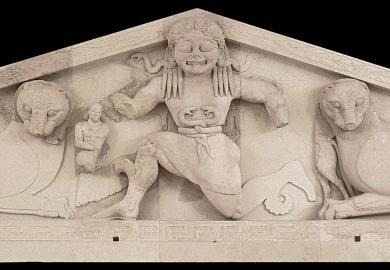
10
New cards
Temple of Aphaia, East Pediment
Early 5th Century, Early Classical, Aigina
* Later pediment, finished early 5th century
* Both depict the Trojan war with Athena at the centre and soldiers fighting on either side of her in various states of battle
* East pediment is provably slightly more succesful as it is not exactly symmetrical and Athena is actively involved (the beginning of gods walking among men?)
Dying warriors-
EAST (c.480BC):
* Head fully turned
* Very complex position (neither simply frontal nor simply profile)
* Body is continuously rotated through a series of gradually changing planes
* Clear muscle definition
* More potential for movement
* Facial hair shown - differentiation of ages
* Slight facial expression
* Hips are frontal
* Right hand fisted while the other clutches the shield
* Arms both at right angles, but suggests natural progression.
* Controlled sequence of movements - body is continuously rotated through a series of gradually changing planes.
* Later pediment, finished early 5th century
* Both depict the Trojan war with Athena at the centre and soldiers fighting on either side of her in various states of battle
* East pediment is provably slightly more succesful as it is not exactly symmetrical and Athena is actively involved (the beginning of gods walking among men?)
Dying warriors-
EAST (c.480BC):
* Head fully turned
* Very complex position (neither simply frontal nor simply profile)
* Body is continuously rotated through a series of gradually changing planes
* Clear muscle definition
* More potential for movement
* Facial hair shown - differentiation of ages
* Slight facial expression
* Hips are frontal
* Right hand fisted while the other clutches the shield
* Arms both at right angles, but suggests natural progression.
* Controlled sequence of movements - body is continuously rotated through a series of gradually changing planes.
11
New cards
Temple of Aphaia, West Pediment
Late 6th Century, Archaic, Aigina
* Earliest pediment, finished late 6th century
* Athena stands solemnly in middle, flanked by combatants flanked by archers. Concluded by dying warriors.
* Theme of violence presided over by god (to fill apex)
* Figures in combat, striding, standing, falling, kneeling, dying in corners (lower heads without affecting scale).
* Athena stands solemnly, duellists, archers, dying figures.
* Dying figure: right leg folded over left, echoes arm, complex, beautiful design, repetition: placement of limbs, locks of hair, therefore gaps arm/body, leg/body, body/ground. Head, shoulders, hips all face front.
* Looks like it is all pushed out from centre, falling to sides, whereas East pushes out and then back again at ends.
Dying warriors-
WEST (c.510BC):
* Beaded hair
* Triangles (waste of space)
* Very stationary
* Frontal chest and torso are incompatible with sideways legs - no twist of the hips
* Serene expression (archaic smile)
* Unnatural leg position
* Unnatural angle of left arm (would not support the body at that angle)
* Heavy use of right angles - sharp turns
* Some muscle definition
* Use of repetition as compositional and decorative device.
* Earliest pediment, finished late 6th century
* Athena stands solemnly in middle, flanked by combatants flanked by archers. Concluded by dying warriors.
* Theme of violence presided over by god (to fill apex)
* Figures in combat, striding, standing, falling, kneeling, dying in corners (lower heads without affecting scale).
* Athena stands solemnly, duellists, archers, dying figures.
* Dying figure: right leg folded over left, echoes arm, complex, beautiful design, repetition: placement of limbs, locks of hair, therefore gaps arm/body, leg/body, body/ground. Head, shoulders, hips all face front.
* Looks like it is all pushed out from centre, falling to sides, whereas East pushes out and then back again at ends.
Dying warriors-
WEST (c.510BC):
* Beaded hair
* Triangles (waste of space)
* Very stationary
* Frontal chest and torso are incompatible with sideways legs - no twist of the hips
* Serene expression (archaic smile)
* Unnatural leg position
* Unnatural angle of left arm (would not support the body at that angle)
* Heavy use of right angles - sharp turns
* Some muscle definition
* Use of repetition as compositional and decorative device.